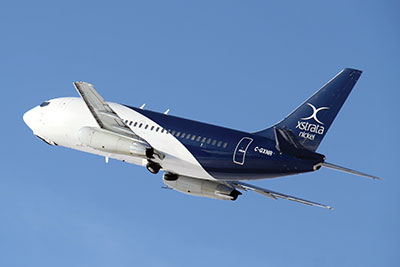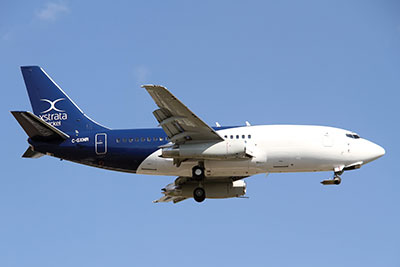
Features
Operations
Glencore’s aerial lifeline
Glencore Xstrata of Baar, Switzerland is one of the worlds largest natural resource companies.
May 7, 2014 By Frederick K. Larkin
Glencore Xstrata of Baar, Switzerland is one of the worlds largest natural resource companies. Its workforce of approximately 190,000 in more than 50 countries produces and markets more than 90 commodities. These include metals, minerals, oil, coal and agricultural products. A treasured piece within this behemoth’s portfolio is its Raglan property in the Nunavik region of Quebec. Situated just south of the 62nd Parallel and 240 miles north of the tree line, the mining complex is accessible only by air. Before reviewing its airborne support, it is worthwhile to briefly discuss the evolution of the operation.
 |
|
| Xstrata added a 1979 Boeing 737-2S2C to its fleet in September 2011. It was refurbished, upgraded and entered service in the fall of 2012. Photos: J.P. Gosselin
|
The company
In February 1995, Falconbridge and five Nunavik Inuit partners signed the Raglan Agreement. This resulted in the development of the Raglan mine that began production in December 1997. Noranda had purchased 19.9 per cent of Falconbridge in 1988 and increased its interest to 58.4 per cent in 2002. In June 2005, the two companies merged and continued as Falconbridge. In August 2006, Falconbridge was acquired by Xstrata of Zug, Switzerland. In August 2011, Xstrata announced a US$530 million program to expand the Raglan operation and to upgrade related facilities including the mill. This is expected to result in a 54 per cent increase in annual production by 2016. Finally, Xstrata merged with Glencore International to create Glencore Xstrata in May 2013.
Throughout this Pac-Man-like corporate activity, the Raglan mine produced increasing amounts of nickel. Today, the Raglan property includes four underground mines, a concentrator, a power plant, a fresh water supply source, a wastewater treatment plant, as well as offices and accommodations for the approximately 700 personnel who are on-site at any given time.
A key component of Raglan’s infrastructure is its Donaldson Airport (CTP9) at Kattiniq. Located 12 miles east of the mining complex and 1,120 miles due north of Dorval, its 6,500-by-150-feet gravel runway is 1,900-feet ASL. In addition to a terminal building equipped with backup generators, the airfield has a ground power unit, a GS700 de-icer unit, a fire truck with trained personnel and a Bandvagn 206 articulated all-terrain tracked vehicle that is equipped with an infrared camera and synthetic vision in the event of an off-airport rescue mission.
The mission
Glencore Canada’s flight department has a straightforward role: provide logistical support for the ongoing activities at a remotely located mining operation. In the case of Raglan, this means carrying more than 50,000 passengers and in excess of three million pounds of cargo per year. Given that each Raglan resident consumes about 30 pounds of food per week, perishables are an important item on the manifest of northbound flights. A wide range of goods that consist of equipment and parts required to keep the mines producing are also carried. These often include dangerous goods such as fuel samples (diesel and Jet A), paint and lubricants.
The aircraft
Given the tasks associated with this flight department’s mission, the ideal aircraft has to be capable of moving personnel, supplies and equipment in a timely fashion, yet be able to operate out of airports with unpaved surfaces. The Boeing 737-200C has been doing this for airlines and corporations for 45 years and is therefore the perfect airplane to meet Glencore’s needs.
In addition to the large cargo door on the forward port side of the fuselage, strengthened cabin floor and an integral air stair at the main cabin door, 737-200Cs have a gravel kit that includes a nose-gear deflector and vortex dissipators on each engine nacelle. Powered by two Pratt & Whitney JT8D17A engines that each provide 16,000 pounds of thrust, the aircraft has a MTOW of 128,000 pounds.
Over the past four decades, these workhorses served in northern Canada with airlines such as Nordair, NWT Air, Pacific Western and Transair, as well as for corporations including Dome Petroleum, Eldorado Nuclear and Imperial Oil. Today, they continue to ply the northern skies for Air Inuit, Air North, Canadian North, First Air, Nolinor and Starlink.
Glencore operates a pair of 200Cs. In keeping with its emphasis on safety, the company has significantly upgraded the avionics on both its 737s with the latest generation of weather radar that has the ability to predict wind shear activity, a terrain awareness and warning system (TAWS), a traffic collision avoidance system (TCAS) and dual Wide Area Augmentation System-Localizer Performance with Vertical Guidance (WAAS-LPV) receivers. The latter system forgoes the need for ground-based navigation aids and provides 256-foot minimums for approaches to Donaldson Airport’s runway 11/29.
Furthermore, both aircraft have a Class C fire suppression system that can extinguish a fire in the cargo compartment completely separate from the passenger compartment. There is also a certified pressurization differential between the passenger and cargo compartment on each aircraft.
The operations
Raglan’s employees work to a rotating schedule that sees them spend three weeks on-site followed by two weeks off-site. This requires a constant movement of personnel between the complex and southern locations.
The two aircraft fly scheduled services through the week connecting Kattiniq with Rouyn-Noranda, Quebec City, Montreal and Toronto. The two longest legs flown are between Kattiniq and Quebec City (2:30) and between Kattiniq and Rouyn-Noranda (2:15).
The passengers are either employees or contractors and the load factor tends to be 100 per cent. While these flights are all business, with no tourists aboard, in-flight meals are served. As passenger loads can vary, the cabins of the two 737s have flexible configurations. The normal layout provides seats for 76 passengers and two pallets that hold 13,000 pounds of freight. Should there be a need to carry a different mix of people and cargo, the following seat/pallet arrangements are available: 60/3, 34/4 or 24/5.
When a dedicated cargo flight is required, either aircraft is able to carry six pallets without any passengers.
Each 737 flies approximately 1,100 hours per year. Routine maintenance is performed while they rest over the weekend at Toronto Pearson International Airport’s Hangar 1. Heavy work is contracted out via competitive bid as required.
The team
Glencore Canada’s flight department is a tight team of 22 individuals. This includes eight pilots, eight aircraft maintenance engineers, four flight attendants and two administrators. The AMEs also act as loadmasters.
Owing to the group’s cohesive nature, the level of employee turnover has been low. Having said that, there has recently been a change at the helm of the department. After almost 13 years, Robert (Bob) Lierschaft has retired as director of aviation and handed the controls over to Dean Carroll who had been director of flight operations as well as a 737 captain.
When asked to describe the culture of the group, Carroll commented, “Safety behaviour is fully integrated into everything we do. I promote a questioning attitude and we work hard to resist complacency. We are all committed to excellence with respect to safety matters.”
Fleet history
While the Glencore Canada name is new to the Canadian business aviation scene, its two predecessor companies operated aircraft over many earlier decades.
 |
|
| Glencore Canada’s flight department is a tight team of 22 individuals. This includes eight pilots and eight aircraft maintenance engineers. |
Noranda flew a Lockheed 18 Lodestar from 1959 until 1968. It was replaced by a Grumman Gulfstream I turboprop, that was in turn sold when a Gulfstream II jet arrived in 1973. While the G2 was sold in 1987, Noranda operated smaller aircraft including a Learjet 25D, an HS-125-700A, a Learjet 55, a Falcon 10 and a King Air 300 until 2000. Falconbridge also operated a mixed fleet that included a Hiller UH-12E, a Beech Baron and a Gulfstream II between 1964 and 1983.
As the development of the Raglan property progressed, Noranda purchased its first jet freighter. “C-GJLN,” a 1968 Boeing 737-210C, arrived in May 1997. In October 2001, it was transferred to Falconbridge and remained with the company until June 2005. Its replacement was “C-FFAL,” a 1979 Boeing 737-2R8C that joined Falconbridge in January 2005 and entered service late that spring. As a result of expanded operations at Raglan another jet was needed. “C-GXNR,” a 1979 Boeing 737-2S2C, was added to the fleet in September 2011. After undergoing a substantial refurbishment and upgrading of onboard systems, it entered service in the fall of 2012. Today, the two jets provide an indispensible service.
The future
When asked why the company doesn’t farm out the responsibility of transporting personnel and supplies to commercial operators, both Lierschaft and Carroll explained it is due to a desire to have control over safety, costs and scheduling. Whether it relates to the customized design and installation of the aircraft’s systems, their maintenance regime, crew training programs, oversight of all expenditures or the ability to schedule flights as required, the company believes it is in the best interest of its employees and its owners to have full authority over air support for the mine.
Carroll also noted that having direct control over safety issues has enabled the team to achieve “zero harm to our personnel, the environment and property.” He pointed out that natural resource companies face significant challenges related to extreme weather conditions, remote locations and the need to move heavy critical cargo, including dangerous goods, on a regular basis. “Planning is a major part of our work in providing a lifeline to the mine,” he said.
Having operated a safe, reliable and efficient airlift up to Raglan for more than 17 years, this attention to detail has paid dividends. Not one incident has occurred during that period. The safety record of the flight department relates well to the safety standards of the company’s mining operations.
It has been estimated that the Raglan property has another 20 to 25 years of mine life left. The company expects that its two 737s will be around for another 15 years, given planned annual utilization. Nonetheless, it begs the question about a potential replacement aircraft type.
Due to the high cost of certifying a gravel kit for newer variants of the 737, it is felt that a high-speed turboprop might have to be the default aircraft. The Bombardier Q400 appears to be the most likely candidate, although its slower speed and narrower cabin would not provide an ideal upgrade from the trustworthy 737-200 Combis.
In the meantime, Glencore Canada’s employees, contractors and owners can rest assured that this vital function will continue to be performed in a professional manner by the men and women of its flight department.